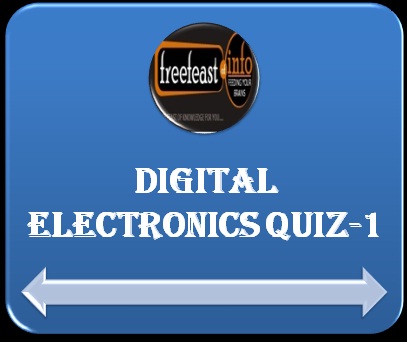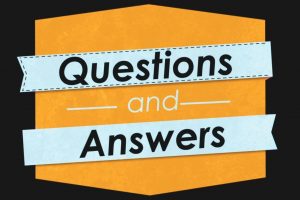Digital electronics interview questions
In this article we will learn about the digital electronics interview question. Which is mainly asked in various interview.
Digital electronics interview questions
1. What is meant by radix (or base) of a number system?
Radix or base of number system is the number of digits or distinct symbols it uses to represent various numbers.
2. What is weighted code? Give one example.
In a weighted code the value of a digit in a 4-bit depends on its position such as in BCD code.
3. What is non-weighted code?
In a non-weighted code, no definite weights are assigned to the four digit positions such as in excess-3 code.
4. What is difference between LSB and MSB?
The right most bit of a binary number is called least-significant bit (LSB) while the left most bit of a binary number is known as most-significant bit (MSB).
5. What is meant by BCD code?
BCD code is a decimal system with each digit encoded in its binary equivalent of 4 bits.
6. What is excess-3 code |?
Excess-3 code is derived from the natural BCD code by adding 3(0011) to each coded number.
7. Why hexadecimal code is widely used in digital system?
It is very convenient to enter binary data in a digital system using hex code.
8. What is the difference between binary code and BCD?
BCD is not a number system like binary. It is a decimal system with each decimal digit encoded in its binary equivalent. A straight binary code takes the complete decimal number and represents it in binary while the BCD code converts each decimal digit to binary individually. It is most useful digital electronics interview question because mostly come in interview exam.
9. Explain the use of excess-3 code.
The key feature of the excess-3 code is that it is self-complementing code. It means that 1’s complement of the coded number yields 9’s complement of the number itself. The self-complementing property makes the excess-3 code useful in some arithmetic operations, because subtraction can be performed using9’s complement method and 1’s complement can be easily produced with digital logic circuits by simply inverting each bit.
10. What are the advantages of gray code?
In Gray code, if we go from any one decimal number to the next, only one bit of the Gray close changes. Because of this feature, an amount of switching is minimized and the reliability of the switching systems is improved. Advantage of gray code is main interview question of digital electronic.
11. What is an alphanumeric code?
The codes used for representing letters of alphabet. Punctuation marks and other special characters along with numbers are called alphanumeric codes.
12. What is Boolean algebra?
Boolean algebra is a mathematical system of logic in which truth functions are expressed as symbols are manipulated to arrive at conclusion. It is also maximum asked in digital electronics interview question.
13. What are the basic logic elements?
Basic logic elements are NOT gate, AND gare, OR gate and the flip-flop.
14. What is a truth table?
Truth table is a table that gives outputs for all possible combinations of inputs to a logic circuit.
15. Define the positive logic and negative logic?
If the higher of the two voltages represents a 1 and the lower voltage represents a 0 , the logic is called a positive logic. On the other hand, if the lower voltage represents a 1 and the higher voltage a 0, we have a negative logic.
16. What is pulse logic system?
A logic system in which a bit is recognized by the presence or absence of a pulse is called a pulse or dynamic logic system.
17. What is an inverter?
An inverter is logic gate whose output is the inverse or complement of its input.it is main equipment of digital electronic system which is asked in interview.
18. What is the specialty of NAND and NOR gates?
The specialty of NAND and NOR gates is that they are universal gates and can perform all the basic logical operations.
19. What is associate law?
Associate law is a law of addition and multiplication and according to this law grouping of the variables in the ORing or ANDing of several variables is immaterial and the results obtained are the same.
20. what is minterm ?.
A term containing literals corresponding to all the variables in ANDed terms ORed terms ANDed together.
21. What is maxterm in digital electronic system?
A term containing literals corresponding to all the variables in ORed from is known as a maxterm.
22. what is the difference between canonical form and standard form?
In Canonical form , a Boolean function is expressed as sum of minterms or product of maxterms and is obtained by reading a function from the truth table. Canonical forms may or may not contain the least numbers of literals because by definition, each maxterm or minterm must contain all variables, complemented or un complemented. In standard form, the terms of function may contain one, two or any number of literals. Standard form is expressed as sum products or product of sums.
23. what is the use of De Morgan’s theorem.?
De Morgan’s theorems are extremely useful in simplification of Boolean expressions in which a sum or product of variables is inverted.
24. What is karnaugh map?
The limitation of karnaughs map is that beyond 6 variables it becomes very cumbersome and so it is generally used up to 6 variables.
25. What is the use of a karnaugh map?
Karnaugh map is used for simplification and manipulation of Boolean expressions.
26. What is a half-adder?
A logic circuit, that can add two 1-bit numbers and produce outputs for sum and carry, is called a half adder.
27. What is full-adder?.
A binary adder, which can add two 1-bit binary numbers along with a carry bit a produces outputs for sum and carry is called a full-adder.
28. What is logic signal required to inhibit a NAND gate and what is its output when inhibited?
Logic 0 is the logic signal required to inhibit a NAND gate and 1 is its output, irrespective of all other inputs, when inhibited.
29. What is multiplexing?
Multiplexing is an operation performed with digital logic circuits several lines into single lines into a single line in a specified sequence.
30. What is an encoder?
An encoder is a logic circuit that produces coded binary inputs from encoded inputs.
31. What is a DE multiplexer?
DE multiplexer is a logic circuit that accepts one data input and distributes it over several outputs.it is also most important interview question of digital electronics.
32. What is a decoder?
Decoder is a logic circuit that decodes from binary to octal decimal, hexadecimal, or any other code such as 7-segment circuit etc.
33. What is sequential circuit?
Sequential logic circuit is that circuit in which outputs of the circuit remain in their state, until instructed to change it. In other words sequential logic circuit may be defined as that logic circuit whose outputs are determined by the sequence in which input signal are applied.
34. What is a flip-flop?
A flip-flop is a basic memory element that is made of an assembly of logic gates and is used to store 1-bit of information. Flip flop is main subject of digital electronics which are mostly asked in interview.
35. What is a latch?
It is a D-type of flip-flop and stores one bit of data.
36. What is an excitation table?
Excitation table gives information about what should be the flip-flop inputs if the outputs are specified before and after the clock pulses.
37. What is a state table?
State table consists of complete information about present state, next state, and out puts of a sequential circuit.
38. What is meant by a counter?
Counter is a digital circuit which is used to count pulses and give the output in the binary form. These are also main interview question of digital electrics.
39. What is difference between synchronous and asynchronous counters?
In a synchronous counter all the flip-flops get clocked simultaneously where as in an asynchronous counter the output of one flip-flop drives another flip-flop.
40. What is a ripple counter?
When the output of one flip flop drives another flip flop, the counter is called a ripple counter.
Hence these are some digital electronics interview questions. If you have any query in theses question you must comment below in comment box.
If you want to more about digital electronics system you must watch this video.

